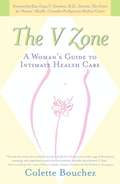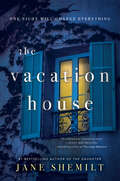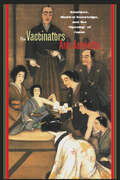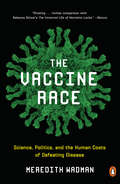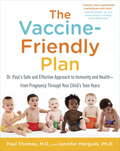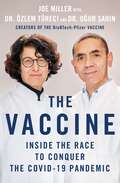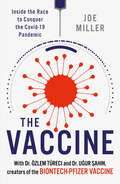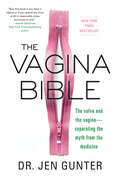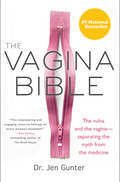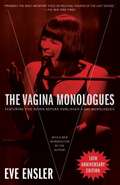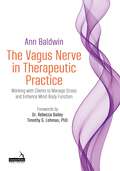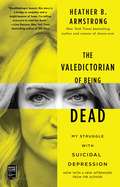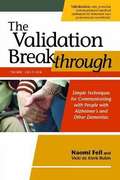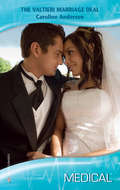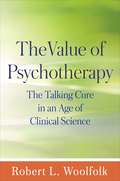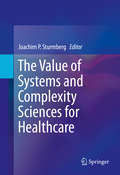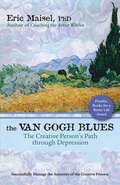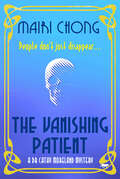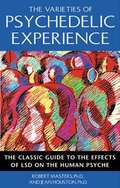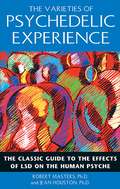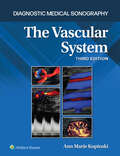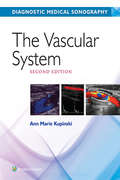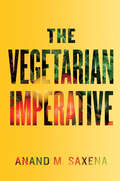- Table View
- List View
The V Zone: A Woman's Guide to Intimate Health Care
by Colette BouchezThe V Zone answers those difficult and embarrassing questions women often are unable to ask their own doctor. Colette Bouchez, an award winning medical journalist, explains important health information in easy-to-understand language, and offers women a clear, concise plan for dealing with the most common gynecological complaints. In addition to describing currently available medical treatments, The V Zone reports on natural and alternative solutions, and helps navigate the wide array of over-the-counter products, including menstrual aids, home test kits, and feminine hygiene products. Know instantly what's safe to use, what's not, when it's okay to self-treat, and when it's time to seek professional care. Also included is the latest information on: vaginitis, painful sex urinary tract infections, yeast infections, STDs, and much more! With advice from over two dozen medical experts, The V Zone is the definitive guide women can turn to and rely on, today and for years to come.
The Vacation House: A Novel
by Jane ShemiltThe Edgar-nominated, #1 internationally bestselling author of The Daughter and The Playground weaves a breathtaking tale of betrayal, family, and secrets from the past in this crackling novel of psychological suspense.Two women. Two secrets. One terrible night.PAXOS, GREECEThe vacation house is a luxurious getaway for a wealthy English family, windows open to sun and the sea, a sparkling swimming pool, and a verdant garden. One hot summer night, while the parents and their friends drink wine and amuse themselves, a young woman—the teenage daughter of the Greek caretaker—ventures for a walk on their private beach. Her life will never be the same again.LONDON, ENGLAND, TEN YEARS LATERJulia is the perfect spouse and mother. Slender, blonde, expensively dressed, she’s the classic “yummy mummy” of high society: cook, organizer, arm candy, and speechwriter to her influential husband.But behind her winning smile is a stifled woman trapped in a gilded cage, stricken with anxiety and perfectionism. When Julia meets Laurel, a therapist who promises to help her find fulfillment, Julia opens herself up to the hope of a different future.BOUND BY THE PASTWhat happened in Greece all those years ago that binds these two women together? And will uncovering the truth destroy everything… or set them free?
The Vaccinators
by Ann JannettaIn Japan, as late as the mid-nineteenth century, smallpox claimed the lives of an estimated twenty percent of all children born--most of them before the age of five. When the apathetic Tokugawa shogunate failed to respond, Japanese physicians, learned in Western medicine and medical technology, became the primary disseminators of Jennerian vaccination--a new medical technology to prevent smallpox. Tracing its origins from rural England, Jannetta investigates the transmission of Jennerian vaccination to and throughout pre-Meiji Japan. Relying on Dutch, Japanese, Russian, and English sources, the book treats Japanese physicians as leading agents of social and institutional change, showing how they used traditional strategies involving scholarship, marriage, and adoption to forge new local, national, and international networks in the first half of the nineteenth century. The Vaccinators details the appalling cost of Japan's almost 300-year isolation and examines in depth a nation on the cusp of political and social upheaval.
The Vaccine Race: Science, Politics, and the Human Costs of Defeating Disease
by Meredith Wadman“This is a story about the war against disease—a war without end—and the development of enormously important vaccines, but in telling that story, in showing how science works, Meredith Wadman reveals much more. I loved this book.” —John M. Barry, New York Times bestselling author of The Great InfluenzaThe epic and controversial story of a major breakthrough in cell biology that led to the conquest of rubella and other devastating diseases. Until the late 1960s, tens of thousands of American children suffered crippling birth defects if their mothers had been exposed to rubella, popularly known as German measles, while pregnant; there was no vaccine and little understanding of how the disease devastated fetuses. In June 1962, a young biologist in Philadelphia, using tissue extracted from an aborted fetus from Sweden, produced safe, clean cells that allowed the creation of vaccines against rubella and other common childhood diseases. Two years later, in the midst of a devastating German measles epidemic, his colleague developed the vaccine that would one day wipe out homegrown rubella. The rubella vaccine and others made with those fetal cells have protected more than 150 million people in the United States, the vast majority of them preschoolers. The new cells and the method of making them also led to vaccines that have protected billions of people around the world from polio, rabies, chicken pox, measles, hepatitis A, shingles and adenovirus. Meredith Wadman’s masterful account recovers not only the science of this urgent race, but also the political roadblocks that nearly stopped the scientists. She describes the terrible dilemmas of pregnant women exposed to German measles and recounts testing on infants, prisoners, orphans, and the intellectually disabled, which was common in the era. These events take place at the dawn of the battle over using human fetal tissue in research, during the arrival of big commerce in campus labs, and as huge changes take place in the laws and practices governing who “owns” research cells and the profits made from biological inventions. It is also the story of yet one more unrecognized woman whose cells have been used to save countless lives. With another frightening virus imperiling pregnant women on the rise today, no medical story could have more human drama, impact, or urgency today than The Vaccine Race.From the Hardcover edition.
The Vaccine-Friendly Plan: Dr. Paul's Safe and Effective Approach to Immunity and Health-from Pregnancy Through Your Child's Teen Years
by Paul Thomas Jennifer MargulisAn accessible and reassuring guide to childhood health and immunity from a pediatrician who's both knowledgeable about the latest scientific research and respectful of a family's risk factors, health history, and concerns In The Vaccine-Friendly Plan, Paul Thomas, M.D., presents his proven approach to building immunity: a new protocol that limits a child's exposure to aluminum, mercury, and other neurotoxins while building overall good health. Based on the results from his pediatric practice of more than eleven thousand children, as well as data from other credible and scientifically minded medical doctors, Dr. Paul's vaccine-friendly protocol gives readers * recommendations for a healthy pregnancy and childbirth * vital information about what to expect at every well child visit from birth through adolescence * a slower, evidence-based vaccine schedule that calls for only one aluminum-containing shot at a time * important questions to ask about your child's first few weeks, first years, and beyond * advice about how to talk to health care providers when you have concerns * the risks associated with opting out of vaccinations * a practical approach to common illnesses throughout the school years * simple tips and tricks for healthy eating and toxin-free living at any age The Vaccine-Friendly Plan presents a new standard for pediatric care, giving parents peace of mind in raising happy, healthy children.
The Vaccine: Inside the Race to Conquer the COVID-19 Pandemic
by Joe Miller Özlem Türeci Ugur SahinWinners of the Paul Ehrlich PrizeThe dramatic story of the married scientists who founded BioNTech and developed the first vaccine against COVID-19.Nobody thought it was possible. In mid-January 2020, Ugur Sahin told Özlem Türeci, his wife and decades-long research partner, that a vaccine against what would soon be known as COVID-19 could be developed and safely injected into the arms of millions before the end of the year. His confidence was built upon almost thirty years of research. While working to revolutionize the way that cancerous tumors are treated, the couple had explored a volatile and overlooked molecule called messenger RNA; they believed it could be harnessed to redirect the immune system's forces against any number of diseases. As the founders of BioNTech, they faced widespread skepticism from the scientific community at first; but by the time Sars-Cov-2 was discovered in Wuhan, China, BioNTech was prepared to deploy cutting edge technology and create the world’s first clinically approved inoculation for the coronavirus.The Vaccine draws back the curtain on one of the most important medical breakthroughs of our age; it will reveal how Doctors Sahin and Türeci were able to develop twenty vaccine candidates within weeks, convince Big Pharma to support their ambitious project, navigate political interference from the Trump administration and the European Union, and provide more than three billion doses of the Pfizer/BioNTech vaccine to countries around the world in record time.Written by Joe Miller—the Financial Times’ Frankfurt correspondent who covered BioNTech’s COVID-19 project in real time—with contributions from Sahin and Türeci, as well as interviews with more than sixty scientists, politicians, public health officials, and BioNTech staff, the book covers key events throughout the extraordinary year, as well as exploring the scientific, economic, and personal background of each medical innovation. Crafted to be both completely accessible to the average reader and filled with details that will fascinate seasoned microbiologists, The Vaccine explains the science behind the breakthrough, at a time when public confidence in vaccine safety and efficacy is crucial to bringing an end to this pandemic.
The Vaccine: Inside the Race to Conquer the COVID-19 Pandemic
by Joe Miller Ugur SahinWhen the world stopped, all hopes rested on finding a vaccine. An unlikely team answered the call. Before Covid-19 was even given its name, a select group of scientists in Germany, assembled by married couple and decades-long research partners Ugur Sahin and Özlem Türeci, began building 20 potential vaccines.As the deadly disease spread from country to country, what followed was a desperate race against time to conduct rigorous tests and clinical trials, whilst navigating political interference and seeking the support of the pharmaceutical industry.Shedding a light on the science behind the breakthrough, The Vaccine tells the story of the trailblazers who led the fightback against Covid-19, whose discoveries could now help the world tackle cancer, along with many other pervasive diseases. It draws back the curtain on one of the most important medical achievements of our age, containing contributions from the fascinating couple themselves, as well as more than 60 scientists, politicians, public health officials, and BioNTech staff.More suspenseful than a novel, this is a real-life story of an extraordinary race against time to save the world.
The Vagina Bible: The Vulva and the Vagina: Separating the Myth from the Medicine
by Dr. Jen GunterInstant New York Times, USA Today, and Publishers Weekly bestseller!Boston Globe bestseller#1 Canadian BestsellerOB/GYN, The New York Times columnist, host of the show Jensplaining, and internationally bestselling author Dr. Jen Gunter now delivers the definitive book on vaginal health, answering the questions you&’ve always had but were afraid to ask—or couldn&’t find the right answers to. She has been called Twitter&’s resident gynecologist, the Internet&’s OB/GYN, and one of the fiercest advocates for women&’s health…and she&’s here to give you the straight talk on the topics she knows best. Does eating sugar cause yeast infections? Does pubic hair have a function? Should you have a vulvovaginal care regimen? Will your vagina shrivel up if you go without sex? What&’s the truth about the HPV vaccine? So many important questions, so much convincing, confusing, contradictory misinformation! In this age of click bait, pseudoscience, and celebrity-endorsed products, it&’s easy to be overwhelmed—whether it&’s websites, advice from well-meaning friends, uneducated partners, and even healthcare providers. So how do you separate facts from fiction? OB-GYN Jen Gunter, an expert on women&’s health—and the internet&’s most popular go-to doc—comes to the rescue with a book that debunks the myths and educates and empowers women. From reproductive health to the impact of antibiotics and probiotics, and the latest trends, including vaginal steaming, vaginal marijuana products, and jade eggs, Gunter takes us on a factual, fun-filled journey. Discover the truth about: • The vaginal microbiome • Genital hygiene, lubricants, and hormone myths and fallacies • How diet impacts vaginal health • Stem cells and the vagina • Cosmetic vaginal surgery • What changes to expect during pregnancy and after childbirth • What changes to expect through menopause • How medicine fails women by dismissing symptomsPlus: • Thongs vs. lace: the best underwear for vaginal health • How to select a tampon • The full glory of the clitoris and the myth of the G Spot . . . And so much more. Whether you&’re a twenty-six-year-old worried that her labia are &“uncool&” or a sixty-six-year-old dealing with painful sex, this comprehensive guide is sure to become a lifelong trusted resource.
The Vagina Bible: The vulva and the vagina--separating the myth from the medicine
by Jen GunterFrom Canadian OB/GYN, women's health advocate and New York Times columnist Dr. Jen Gunter: The Vagina Bible is a comprehensive, accessible antidote to the maelstrom of misinformation around female sexual health, and the ultimate guide to everything a person needs to know about the vagina and vulva.We are well into the twenty-first century and have access to more information than ever before, yet many people don't know that a vagina is self-cleaning, condoms should be used with a lubricant, eating sugar doesn't cause a yeast infection, and sex shouldn't be painful. As a physician with twenty-five years of clinical experience, Dr. Jen Gunter is all too familiar with the fears, fallacies and misinformation that abound about vaginal health. On Twitter, she hilariously exposes unscientific wellness advice and debunks potentially harmful and stunningly unnecessary products from "vagina profiteers." Dr. Gunter knows the questions women (and men) have about female sexual health, and in The Vagina Bible, she answers them all. For: * the sixteen-year-old trying to figure out tampons; * the twenty-six-year-old wondering how to avoid a UTI; * the thirty-six-year-old trans woman navigating her new anatomy; * the forty-six-year-old worried about the changing appearance of her vulva; * the fifty-six-year-old looking into the HPV vaccine for her daughter (and maybe herself); * the sixty-six-year-old experiencing painful sex;The Vagina Bible offers a repository of accurate information based on science, and delivered with wit and wisdom. This is the fact-based, inclusive, and empowering guide you deserve to advocate for your own body.
The Vagina Monologues (10th Anniversary Edition)
by Eve Ensler"I was worried about vaginas. I was worried about what we think about vaginas, and even more worried that we don't think about them... So I decided to talk to women about their vaginas, to do vagina interviews, which became vagina monologues. I talked with over two hundred women. I talked to old women, young women, married women, single women, lesbians, college professors, actors, corporate professionals, sex workers, African American women, Hispanic women, Asian American women, Native American women, Caucasian women, Jewish women. At first women were reluctant to talk. They were a little shy. But once they got going, you couldn't stop them." So begins Eve Ensler's hilarious, eye-opening tour into the last frontier, the forbidden zone at the heart of every woman. Adapted from the award-winning one-woman show that's rocked audiences around the world, this groundbreaking book gives voice to a chorus of lusty, outrageous, poignant, and thoroughly human stories, transforming the question mark hovering over the female anatomy into a permanent victory sign. With laughter and compassion, Ensler transports her audiences to a world we've never dared to know, guaranteeing that no one who reads The Vagina Monologues will ever look at a woman's body the same way again.
The Vagus Nerve in Therapeutic Practice: Working with Clients to Manage Stress and Enhance Mind-Body Function
by Ann BaldwinThe Vagus Nerve in Therapeutic Practice describes practical, science-based techniques that can be used to improve vagal performance with the goal of restoring and maintaining mind-body health. Aimed at complementary medicine practitioners and holistic healers such as massage therapists, biofield practitioners, nutritional therapists, aromatherapists and energy healers, it explains how practitioners can adapt their modalities to stimulate the vagus nerve, together with other cranial nerves and the limbic system, to enhance their clients' experience and improve outcomes.The book provides a clear understanding of the importance and benefits of self-regulating the autonomic nervous system, focusing on the vagus nerve. This nerve controls the stress response, regulates digestion, modulates the immune system, and releases an anti-inflammatory neurotransmitter, acetylcholine; when it functions inadequately, all of these systems can be adversely affected. By learning techniques to stimulate the vagus nerve, practitioners can help those experiencing low-level inflammation and emotional stress, including those with chronic diseases. Each chapter provides practical, evidence-based methods that can be used to stimulate the ventral vagal complex, illustrated by a case history from a complementary medicine or holistic practice. The author addresses the anatomy and evolution of the vagus nerve, including its possible role in promoting social engagement, using the polyvagal theory as a model. The functions of major branches of the vagus nerve and other neighbouring cranial nerves are discussed in turn; in each case the mechanism by which neural stimulation improves relaxation and health is outlined, and a practical way to engage the nerve branch and limbic system is described with the help of a case study. An addendum includes an easily referenced summary of the exercises described throughout the book, as well as routines for utilizing combinations of the exercises on a daily, weekly and monthly basis.This book will enable healthcare professionals to attain a solid grasp of the clinical significance of regulating the vagus nerve and provide them with simple ways to do it.
The Valedictorian of Being Dead: The True Story of Dying Ten Times to Live
by Heather B. ArmstrongFrom New York Times bestselling author and blogger Heather B. Armstrong comes an honest and irreverent memoir—reminiscent of the New York Times bestseller Brain on Fire—about her experience as one of only a few people to participate in an experimental treatment for depression involving ten rounds of a chemically induced coma approximating brain death.For years, Heather B. Armstrong has alluded to her struggle with depression on her website, dooce. It’s scattered throughout her archive, where it weaves its way through posts about pop culture, music, and motherhood. But in 2016, Heather found herself in the depths of a depression she just couldn’t shake, an episode darker and longer than anything she had previously experienced. She had never felt so discouraged by the thought of waking up in the morning, and it threatened to destroy her life. So, for the sake of herself and her family, Heather decided to risk it all by participating in an experimental clinical trial involving a chemically induced coma approximating brain death. Now, for the first time, Heather recalls the torturous eighteen months of suicidal depression she endured and the month-long experimental study in which doctors used propofol anesthesia to quiet all brain activity for a full fifteen minutes before bringing her back from a flatline. Ten times. The experience wasn’t easy. Not for Heather or her family. But a switch was flipped, and Heather hasn’t experienced a single moment of suicidal depression since. Disarmingly honest, self-deprecating, and scientifically fascinating, The Valedictorian of Being Dead brings to light a groundbreaking new treatment for depression.
The Validation Breakthrough: Simple Techniques for Communicating with People with Alzheimer's and Other Dementias, Third Edition
by Naomi Feil Vicki de Klerk-RubinValidation is a practical way of communicating with and managing problem behavior in older adults with Alzheimer's type dementia. It helps reduce stress, enhance dignity, and increase happiness. The Validation Breakthrough is an essential resource for all settings providing dementia care including assisted living facilities, nursing homes, skilled nursing facilities, hospice, home health care, adult day services, family care settings, and more.
The Valtieri Marriage Deal
by Caroline AndersonMidwife Isabelle Thompson is convinced it must have been a heady mix of the warm Tuscan sun and the powerful chemistry between herself and obstetrician Luca Valtieri that made her, for once, follow her heart. And it led her right into the gorgeous Italian's bed!Back in London, Isabelle vows never to contact Luca. How can she trust a man she barely knows? Then he arrives in town as her hospital's new obstetrician, and she discovers that their passionate night has left her pregnant! Luca promises Isabelle he can give her the life she's dreamed of...if she agrees to his deal.
The Value of Genetic and Genomic Technologies: Workshop Summary
by Institute of Medicine of the National AcademiesKnowing one's genetic disposition to a variety of diseases, including common chronic diseases, can benefit both the individual and society at large. The IOM's Roundtable on Translating Genomic-Based Research for Health held a workshop on March 22, 2010, to bring together diverse perspectives on the value of genetic testing, and to discuss its use in clinical practice.
The Value of Psychotherapy
by Robert L. WoolfolkPsychotherapy as a discipline is very much in flux. From a seasoned scholar, clinician, and teacher, this engaging book offers a thoughtful and current analysis of where the field is now and where it may be headed. Robert L. Woolfolk illustrates how the growing medicalization of mental health care--in particular, the attempt to fit psychotherapy to the templates of evidence-based medicine--have challenged psychotherapists to reaffirm the value of their work. The book explores ways in which certain kinds of efforts to endow "the talking cure" with greater scientific legitimacy can be problematic. Woolfolk makes a strong case for the benefits of psychotherapy not only as a technology for treating disorders, but also as a practice that can promote practical wisdom and human flourishing.
The Value of Systems and Complexity Sciences for Healthcare
by Joachim P. SturmbergThis visionary reframing of health and healthcare uses a complexity science approach to building healthcare systems that are accessible, effective, and prepared for change and challenges. Its holistic map for understanding the human organism emphasizes the interconnectedness of the individual's physical, psychological, cognitive, and sociocultural functioning. Applications of this approach are described in primary, specialist, and emergency care and at the organizational and policy levels, from translating findings to practice, to problem solving and evaluation. In this model, the differences between disease and illness and treating illness and restoring health are not mere wordplay, but instead are robust concepts reflecting real-world issues and their solutions. Based on the Proceedings of the 1st International Conference of Systems and Complexity for Healthcare, topics covered include: * Coping with complexity and uncertainty: insights from studying epidemiology in family medicine * Anticipation in complex systems: potential implications for improving safety and quality in healthcare * Monitoring variability and complexity at the bedside * Viewing mental health through the lens of complexity science * Ethical complexities in systems healthcare: what care and for whom? * The value of systems and complexity thinking to enable change in adaptive healthcare organizations supported by informatics * If the facts don't fit the theory, change the theory: implications for health system reform The Value of Systems and Complexity Sciences for Healthcare will interest and inspire health and disease researchers, health professionals, health care planners, health system financiers, health system administrators, health services administrators, health professional educators, and, last but not least, current and future patients.
The Van Gogh Blues: The Creative Persons Path Through Depression
by Eric MaiselCreative people will experience depression — that’s a given. It’s a given because they are regularly confronted by doubts about the meaningfulness of their efforts. Theirs is a kind of depression that does not respond to pharmaceutical treatment. What’s required is healing in the realm of meaning.In this groundbreaking book, Eric Maisel teaches creative people how to handle these recurrent crises of meaning and how to successfully manage the anxieties of the creative process. Using examples both from the lives of famous creators such as van Gogh and from his own creativity coaching practice, Maisel explains that despite their inevitable difficulties, creative people possess the ability to forge relationships, repair themselves, and find meaning in their work and their lives. Maisel presents a step-by-step plan to help creative people handle their special brand of depression and rediscover the reasons they are driven to create in the first place.
The Vanishing Patient (The Dr. Cathy Moreland Mysteries)
by Mairi ChongA doctor begins to doubt her own sanity as she investigates a patient&’s wild claims in this new mystery from the author of Lethal Resuscitation . . . Dr. Cathy Moreland is taken aback when an irate patient comes to her practice claiming his ailing wife has been kidnapped by one of her colleagues using a false name. Is someone impersonating a doctor, or is Adam Steer delusional? After looking into Adam&’s claims, she feels reassured that no such thing actually happened—but continues to worry that Steer is mentally unwell. A visit to his home only leads to more alarm. No one answers the door, but Cathy overhears a conversation that convinces her something sinister is going on—and that she herself may be in danger. Cathy&’s own bipolar disorder is well-managed, but she&’s beginning to doubt her own sanity—and others are, too. As strange developments unfold, will she be able to make any sense of the events around her before everything spirals out of control?
The Varieties of Psychedelic Experience: The Classic Guide to the Effects of LSD on the Human Psyche
by Robert Masters Jean HoustonThe research in this book has great significance to the current debate on drug legalization and on the effects of LSD on the human psyche.
The Varieties of Psychedelic Experience: The Classic Guide to the Effects of LSD on the Human Psyche
by Robert Masters Jean HoustonOne of the most important books written on the effects of LSD on the human psyche. • Its authoritative research has great relevance to the current debate on drug legalization. • Prolific authors Robert Masters and Jean Houston are pioneer figures in the field of transpersonal psychology and founders of the Human Potentials Movement. The Varieties of Psychedelic Experience was published in 1966, just as the first legal restrictions on the use of psychedelic substances were being enacted. Unfortunately, the authors' pioneering work on the effects of LSD on the human psyche, which was viewed by its participants as possibly heralding a revolution in the study of the mind, was among the casualties of this interdiction. As a result, the promising results to which their studies attested were never fully explored. Nevertheless, their 15 years of research represents a sober and authoritative appraisal of what remains one of the most controversial developments in the study of the human psyche. Avoiding the wild excesses taken by both sides on this issue, this book is unique for the light it sheds on the possibilities and the limitations of psychedelic drugs, as well as on the techniques for working with them. With drug legalization an increasingly important issue, The Varieties of Psychedelic Experience provides a welcome and much needed contrast to the current hysteria that surrounds this topic.
The Vascular Surgery In-Training Examination Review (VSITE)
by Allen Murga Theodore H. Teruya Ahmed M. Abou-Zamzam Christian BianchiThe field of vascular surgery has been progressing and developing. The training for vascular surgery has progressed to now encompassing 0+5 residency along with 5+2 fellowship, which will then produce more vascular surgeons, as the need for them continues to be in demand. In the process of progressing through two years or five years of training a comprehensive review book is essential for trainees in preparation for boards as well as everyday practice. This textbook will serve as an extremely useful resource primarily for residents and fellows but also for anyone involved with managing vascular surgery disease. It will be a useful tool in preparation for any vascular examination including the VSITE and vascular boards. It will provide a concise and comprehensive summary of vascular surgery disease and serve as an initial platform for further expanding their knowledge of vascular disease processes. All chapters are written by experts in the field and will include the most up to date scientific and clinical information.
The Vascular System (Diagnostic Medical Sonography Series)
by Ann Marie Kupinski Glen SchifrinPart of the highly regarded Diagnostic Medical Sonography series, Ann Marie Kupinski’s The Vascular System, 3rd Edition, thoroughly covers the core content students need to master in today’s rigorous sonography programs. Careful, collaborative editing ensures consistency across all three titles in this series: The Vascular System, Abdomen and Superficial Structures, and Obstetrics and Gynecology, providing the right content at the right level for both students and instructors.
The Vascular System: Diagnostic Medical Sonography Series (Diagnostic Medical Sonography Ser.)
by Ann Marie KupinskiKupinski’s Diagnostic Medical Sonography: The Vascular System, 2nd Edition provides a current, comprehensive treatment of vascular sonography enhanced by six new chapters— Orientation to Ultrasound Scanning (1), Ultrasound Principles (2), Ergonomics: Avoiding Work-Related Injury (3), Sonography in the Venous Treatment Room (21), Evaluation of Penile Blood Flow (31), and Complementary Vascular Imaging (32). And an intregal part of the updated Diagnostic Medical Sonography Series, which includes new editions of Diagnostic Medical Sonography: Abdomen and Superficial Structures, Diagnostic Medical Sonography: Obstetrics and Gynecology, and Diagnostic Medical Sonography: The Vascular System, provides the right content at the right level for the right way to teach and learn.
The Vegetarian Imperative
by Anand M. SaxenaWe have learned not to take food seriously: we eat as much as we want of what we want when we want it, and we seldom think about the health and environmental consequences of our choices. But the fact is that every choice we make has an impact on our health and on the environment. In The Vegetarian Imperative, Anand M. Saxena, a scientist and a vegetarian for most of his life, explains why we need to make better choices: for better health, to eliminate world hunger, and, ultimately, to save the planet. Our insatiable appetite for animal-based foods contributes directly to high rates of chronic diseases—resulting in both illness and death. It also leads to a devastating overuse of natural resources that dangerously depletes the food available for human consumption. The burgeoning population and increasing preference for meat in all parts of the world are stretching planetary resources beyond their limits, and the huge livestock industry is degrading the agricultural land and polluting air and water.Continuing at this pace will bring us to the crisis point in just a few decades—a reality that threatens not only our current lifestyle but our very survival. This book shows us a way out of this dangerous and vicious cycle, recommending a much-needed shift to a diet of properly chosen plant-based foods.Any one of these arguments alone—personal health, worldwide hunger, and environmental degradation—provides reason enough to stop consuming so much animal-based food; taken together, they make an unassailable case for vegetarianism. The Vegetarian Imperative will make you rethink what you eat—and help you save the planet.
